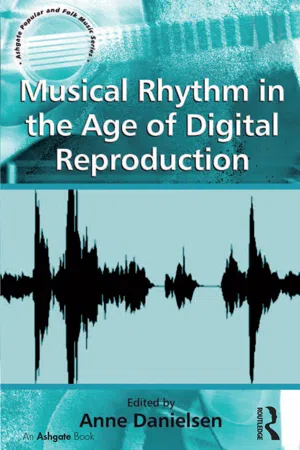Representing Rhythmic Structure
A fundamental premise for the analytical work in this book is that rhythm comprises an interaction between non-sounding reference structures (schemes used by the performer/listener in their respective music-related acts) and sounding rhythmic events. In rhythm, as in music in general, virtual reference structures and actual sounding events inform one another continuously (I discuss these concepts in more detail below). Such virtual reference structures may range from the overall organizing principles of music in general (such as pulse, subdivision and so on), to learned stylistic gestures, to categories established through the patterns introduced by one particular song. Before delving into the difficult question of how to identify and represent these virtual schemes, I will briefly survey some of the literature on rhythm that shares this premise and has supported the theoretical framework of many of the contributions in this book.
Timing variations from a presumed rhythmic norm may be either happenstance or deliberate. In the 1950s, Bengtsson, Gabrielsson, and their colleagues at Uppsala University began exploring what they called ‘systematic variations in duration’ in music. One of the basic hypotheses underlying their work was that these variations are not random occurrences but vital means of musical expression. In an article titled ‘Empirisk rytmforskning’ (‘Empirical Rhythm Research’), they discussed how variations may be used consciously to clarify certain specific structural features of the music, or unconsciously as part of a given tradition’s musical dialect. While the former, also called ‘expressive variations’, occur at particular (and significant) points in the music, the latter, which they called ‘idiomatic variations’, are repeated as part of a recurring rhythmic pattern. Both expressive and idiomatic variations are deliberate. In order to distinguish between expressive and idiomatic variations, they proposed the aforementioned systematic variations (SYVAR), which could encompass musical aspects including frequency, amplitude, envelope and spectrum (Bengtsson et al. 1969: 95-6). Their main theoretical and empirical focus, however, was duration (SYVAR-D), and the systematic variations in the chronometric temporal relations of sonic events.
This emphasis on norm and variation (or, more suggestively, ‘deviation’) has dominated much of the subsequent research on the relationship between rhythmic structure and timing. Kvifte’s research from the 1980s, for example, is clearly inspired by the fundamental assumptions of the Uppsala school, particularly his distinction (in turn influenced by Gregory Bateson) between ‘digital’ and ‘analogue’ aspects of the experience of music: ‘If we encounter a pitch somewhere between C# and D, we divide the experience of pitch in two aspects, one digital (the note “D”) and one analog (“out of tune”)’ (Kvifte 1989: 94).
Clarke’s work on categorical perception in music is also influenced by the pathbreaking theories of the Uppsala school. In his studies of the relationship between rhythmic structure and timing, Clarke investigates how conscious variations – what he calls ‘expressive timing’ – can clarify structural features of music (Clarke 1985, 1987, 1989). Another important issue in Clarke’s research, however, involves the inherent qualities that such variations contribute to the music – using Kvifte’s example, the fact that the D is out of tune is as important to the experience of it as the fact that it can be said to belong to the pitch category ‘D’. Clarke observes, ‘There is considerable evidence that this information [the perceptual information inherent in the variations] is not discarded [in the perceptual process], but is used to make a different sort of perceptual judgment than that associated with the categorical component’ (Clarke 1987: 22). This shift in focus toward the noncategorical or nonstructural aspects of rhythm is clarified in Clarke’s 2000 paper titled ‘Categorical Rhythm Perception and Event Perception’, where he concludes that all acoustical rhythmic information in fact engages two different perceptual domains – expression and rhythm, the latter understood as rhythmic structure (Clarke 2000: 5). In other words, sounding rhythm contains both its relevant structuring pattern and the particular quality of a significant or expressive variation of this pattern.6
6 Clarke uses the term rhythm to denote only its virtual aspects – that is, its structure – when describing how, in classical music, rhythm is a medium for expression (see Clarke 1985: 211). In contrast, I use rhythm to denote the interplay between the sound and its non-sounding virtual aspects. The theoretical framework of Desain and Honing’s studies in rhythm and musical time likewise relies upon a division of musical experience along these lines. Drawing upon Clarke’s work on categorical perception, they state: ‘To make sense of most musical styles, it is necessary to separate the discrete and the continuous components of musical time’ (Desain and Honing 1989: 56). Other studies of microrhythm apply the same theoretical premise. Keil’s writings on participatory discrepancies in jazz represent an early example (Keil 1994a, 1994b, 1995). Butterfield, however, in a recent article, accuses Keil of understating the importance of structural aspects or, in Ke...
